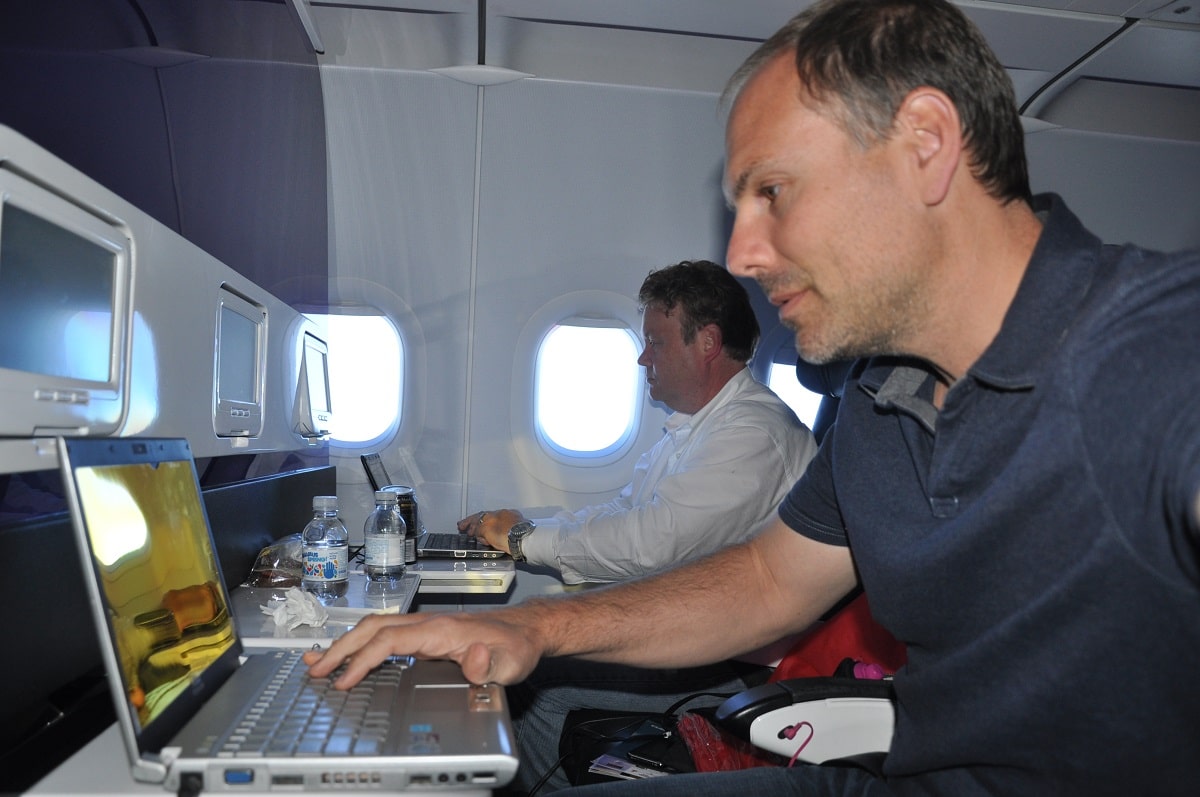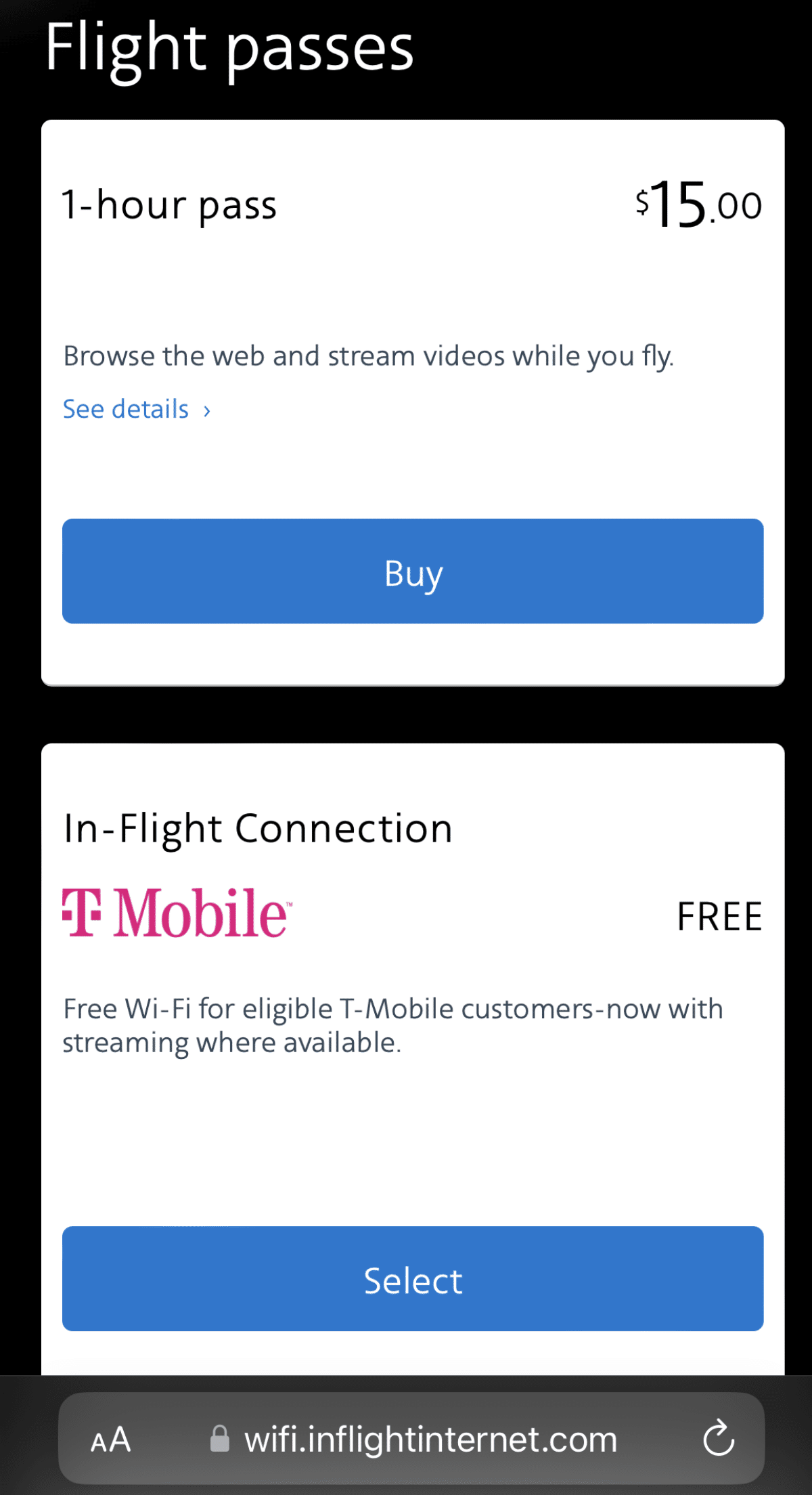This post contains references to products from one or more of our advertisers. We may receive compensation when you click on links to those products. For an explanation of our Advertising Disclosure, visit this page.
I just returned from a three day, two night, work trip, which took me LAX-JFK, LGA-BNA-DFW-LAX. I sat in a wide variety of seats from a luxurious lie-flat seat next to Conan O’Brien to a cramped economy middle seat next to two businessmen who thought they owned my armrests. I worked on almost all of the flights like I do every time I fly. So here are my 12 ways to actually get work done on a plane. RELATED: Why You Need to Let the Passenger Behind You Know That You’re About to Do This

1. Get as much space as possible
With airlines increasing the number of seats on planes and decreasing passengers’ space, it’s imperative to get as much space as possible. If you’re flying business or first, it’s not a problem but it’s very difficult to work in regular coach seats unless you are really short and/or skinny.
When I fly coach, I prefer to sit in the exit row or bulkhead since I know there will be enough room to work. These seats used to be free but now they cost extra unless you’re an elite frequent flier and often times reserved by an elite member. So either pony up the extra cash to sit in one of these seats, or roll the dice and be extra nice to the gate agents in hopes they upgrade one of the frequent fliers and give you the seat for free. Sometimes they will or ask for a seat with an open one next to it. Consult seatguru.com for aircraft configurations and seat dimensions.
Just be careful when paying extra since some airlines like American offer preferred seating for a seat that’s just closer to the front of the plane and not providing extra room.
2. Choose flights with the right WiFi
I know some business travelers prefer to be on flights without WiFi as they don’t want to be connected to their office or distracted by emails but that’s becoming increasingly more difficult. I prefer to be on flights with WiFi — especially those airlines that offer it for free (JetBlue and Delta) or that don’t charge very much (Southwest and United).
 If you’re a T-Mobile customer, you can usually get free WiFi on your phone on American Airlines (AA), Alaska, Delta and United flights. Otherwise, AA charges up to $15 for a one-hour pass.
If you’re a T-Mobile customer, you can usually get free WiFi on your phone on American Airlines (AA), Alaska, Delta and United flights. Otherwise, AA charges up to $15 for a one-hour pass.
3. Download/research in advance
Before getting on a plane, be sure to download all of your emails, just in case an airline swaps out your aircraft for a plane that doesn’t have WiFi at the last minute (it happens), or the WiFi isn’t working. Since I do a lot of research for my work, I usually download those web pages as well and copy and paste the info into a Word document for future offline reference.
4. Make sure you’re fully charged
I also try to book flights on planes that have electrical outlets so I can stay powered up. But just in case they don’t have them or they’re not working, I make sure my devices are all fully charged and I always bring a portable charger. There’s a reason it’s the number one thing flight attendants travel with.
5. Bring the right adaptor
Thankfully most airplanes have power outlets but I also carry a multi-country adaptor for when I’m traveling internationally.
6. Bring a power strip
I always travel with a power strip to charge multiple devices, which is especially helpful if one of the outlets in your row isn’t working. This way you don’t have to fight over the remaining one with your seatmate.
7. Get screen protector
If you don’t like people looking over your shoulder when you’re using your laptop, then get a privacy screen. These lightweight screens prevent your seatmates or passersby from seeing your screen. The only way the screen can be seen is by sitting directly in front of it. Now I can do my work without worrying that someone is watching over my shoulder or reading private information.
8. Watch out for the seat in front of you
Many passengers are oblivious or just plain rude when they are on a plane (here are 10 crazy things I saw on an international flight). If I’m not sitting in a bulkhead seat or exit row, I’m always aware that the person sitting in front of me can (and often does) recline without warning.
When you’re a travel writer and your computer gets smashed mid-flight by someone reclining their seat and the first thing you do is take photos because you know there’s a story there… pic.twitter.com/pq80nES9Oj
— Tarah Chieffi (@tarahchieffi) December 9, 2022
If my laptop is pressed up against their seat and they recline quickly, there’s a good chance my screen will break as it would get trapped in the edge of the lip that holds the tray table. So I always leave my laptop a few inches away from the back of the seat in front of me. Sometimes I will tap the passenger on their shoulder and ask them if they can let me know if they’re going to recline since I’ll be working on my laptop. One time I even made a deal with the passenger in front since the seats were so tight. I told him I’d pay for his in-flight WiFi if he didn’t recline. He agreed!
9. Watch your drink
When using your laptop on a plane, be careful of spills. Whenever the flight attendants come around with the drink cart, I always close my laptop so nothing will spill or accidentally splash on my keyboard.
10. Wear earbuds or noise cancelling headphones
When you have a lot of work to do and need to focus, wear earplugs and/or noise-cancellation headphones to help drown out the ambient noise and the conversations happening around you. It’s also a subtle sign that you don’t want to be disturbed.
The best part about working on the plane is not only does it pass the time but when I land, I can relax and not feel I have to rush to my hotel to catch up. I can enjoy the destination so much more.
So there you have it! My 10 best tips for working on a plane. Did I miss anything? What are your tips? Leave a comment below and tell me!
Note: This post has been updated.
KEEP READING:
–8 Ways To Make Sure An Airline Doesn’t Lose Your Bag … And That You Don’t Get Robbed or Stalked
–The Trick For Getting Airport Luggage Carts for Free
–Airline Lost Your Luggage? Do This If You Want to Get Compensated
–Why Frequent Fliers Use Apple AirTags or Samsung SmartTags When They Travel
–An Airline Executive’s Number One Tip for Avoiding Lost Luggage When You Fly
Want more travel news, tips and deals? Sign up to Johnny Jet’s free newsletter and check out these popular posts: The Travel Gadget Flight Attendants Never Leave Home Without and 12 Ways to Save Money on Baggage Fees. Follow Johnny Jet on MSN, Facebook, Instagram, Pinterest, and YouTube for all of my travel posts.

Great tips and I’ll be sure to follow the lids down policy when the beverage cart is nearby. A bit of a plug here, however being productive also means being connected with consistent and fast Wi-Fi service. Honeywell and Inmarsat are bringing home Wi-Fi speeds to the air with GX Aviation. Soon business and commercial passengers will be able to Skype, game or upload movies and have the same level of Wi-Fi access anywhere around the globe, even out over the oceans. Imagine sitting on one of those super long direct flights at 14 hours plus and having access to family, news, or the office throughout your flight. What a great way to kill time and remain productive and connected. Our three satellites are launched, ground equipment is in place and connections are being tested as I write this. Fast and reliable Wi-Fi is coming early next year.
Amazing tips, thanks for sharing. I am a very frequent business traveler since 2008 and even that got some new thoughts from your post, but honestly, I gave up the laptops and using a tablet + keyboard + external power pack. It is not perfect but saved me a lot of hours on the ground. ;-)